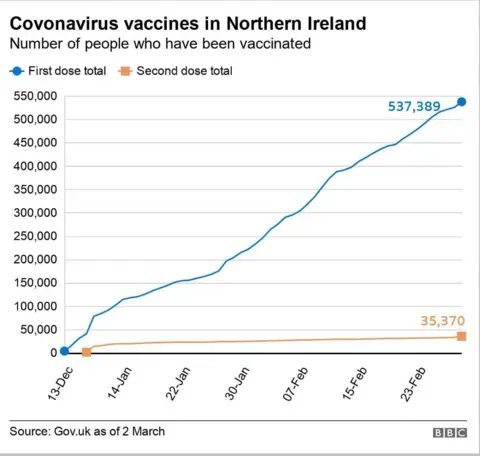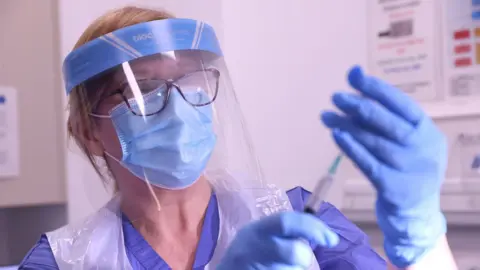Covid-19: Data not dates will be key to ending NI lockdown
 PA Media
PA MediaVarious health factors will influence how quickly Northern Ireland moves through each stage of its lockdown exit plan.
They include how many patients are in intensive care, the numbers being treated on Covid wards, the rate of community transmission and the number of deaths.
According to the health minister it will be data like this, not dates, that will dictate how quickly Northern Ireland reopens.
So where exactly do the figures need to be before decisions are taken and how is the health service intending to manage this?
The overarching plan is to start reopening hospitals again so elective or planned surgery can resume.
At present some surgery is taking place but a huge bulk of it, especially red flag cancer cases, are happening in the private sector.
Based on some of my conversations with health professionals, in order for normal services to restart, both the number of Covid-infected patients in hospital, and the number of people dying each day with the disease, would need to be in single figures - and the closer to zero the better.

A fortnight before restrictions started to ease last May to June, the number of daily deaths were hovering between 0 and 1 for several consecutive weeks.
Also the number of new cases reported each day were fewer than 20. The rate of infection, or R number, swayed between 0.5 and 0.9.
A longer wait for less damage?
Health officials have repeatedly said Northern Ireland's lockdown exit should be be "slow and cautious", and it is apparent the Stormont Executive plans to take its time easing restrictions rather than charging ahead undoing everything that has been achieved.
 Liam McBurney/PA Media
Liam McBurney/PA MediaIt makes perfect sense that if restrictions are eased over three or four months the number of infections, hospitalisations and deaths will be lower than if those restrictions are eased over two months.
A paper that helped influence the shape of Northern Ireland's lockdown exit emerged from the 80th meeting of the Scientific Advisory Group for Emergencies (SAGE) on 11 February.
Its modelling is based around a pace of change that ranges from two to five months; basically, the longer the stretch, the less damage there will be to society.
In recommendations provided by the Scientific Pandemic Influenza Group on Modelling (SPI-M), all scenarios show some form of epidemic resurgence because there are still people in vulnerable groups who have not been vaccinated.
But the numbers reduce the longer that is left between moving from one step to another.
Leaving longer gaps - of, say, four weeks - between each lockdown-easing step should result in fewer hospitalisations and deaths, says the SPI-M group.
By comparison, it adds, if all restrictions were to be lifted between now and the start of May, hospital occupancy would likely reach levels higher than at January's peak - even with a continued successful rollout of vaccines.
Other factors which will help reduce infection rate will be making the wearing of masks compulsory in certain public places, maintaining hand hygiene and avoiding crowding.
Given the level of uncertainty around virus mutations and vaccine supplies, "changes to measures are best made based on epidemiological data rather than based on predetermined dates", says the group.
Deadly curve-ball?
Covid has taken over intensive care beds and hospitals will be reluctant to reopen or switch on non-Covid services until they are back to full Intensive Care Unit (ICU) capacity.
The BBC understands there is a regional de-escalation plan for ICUs - that's likely to mean reducing the number of beds in the Nightingale facility, before cancer care and surgery can be switched back on at the Belfast City Hospital.
Local hospitals also have targets to meet before they can resume normal services.
In Antrim Area Hospital, the target is to have 10 Covid patients in ICU before they can return to full elective surgery.
Currently there are 11, which means that surgery could be resumed in stages from next week.
 Pacemaker
PacemakerThe chief medical officer has said that it will be a slow and gradual start-up.
Factoring in staff leave is also in the mix. Senior managers across the board have told BBC News NI that theatre nurses and, in particular, anaesthetists all need to get a proper rest.
As leave will perhaps be staggered, it will be a challenge for those organising rotas for perhaps months to come.
While it is all very well to plan, an unexpected curve ball could come in the form of another deadly variant.
A significant mitigating factor this time though is the ongoing successful roll-out of vaccines and a better track-and-trace system.
Politicians might argue that while the scores on the doors may not be at a similar level to when we eased out of the first lockdown, the fact that a growing number of the population is vaccinated should mitigate against that.
Four weeks could push figures down considerably - but Northern Ireland still has to get over two significant social hurdles - St Patrick's Day and Easter.
A close eye will also be kept on the Republic of Ireland, both around their number of deaths and new cases, but especially on the roll-out of vaccines.
